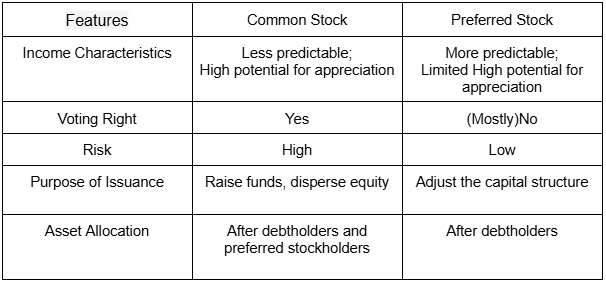Stocks can be categorized into various types based on their characteristics and the rights associated with ownership. The two primary types are common stocks and preferred stocks, each offering distinct features and advantages to investors. Understanding their characteristics and differences is essential for investors and anyone interested in finance.
Common Stock
Common stocks represent a fundamental form of equity security typically issued during an initial public offering (IPO). They signify a claim on a company's assets and earnings. Investors holding common stocks enjoy voting rights and may benefit from profits through dividends and capital appreciation. However, in the event of a company's liquidation, common stockholders rank last in priority. This means they will only receive a payout after all creditors, bondholders, and preferred shareholders are compensated.
Characteristics of Common Stocks
- Ownership and Voting Rights
Common stockholders are direct owners of a stake in the company and hold significant voting rights in key decisions, such as board elections, corporate mergers, acquisitions, and major policies. Generally, each share equals one vote, enabling shareholders to influence the company’s strategic direction.
- Dividends
Dividends on common stocks depend on the company’s financial health and the decisions of its board of directors. Profitable companies may choose to pay dividends, but in cases of poor performance or when profits are reinvested, dividends may not be distributed.
- Risk and Return Potential
Common stocks carry higher risks but offer significant return potential. Their value is influenced by market trends, economic conditions, company performance, and industry competition. While a successful company can drive substantial stock price increases, poor performance or unfavorable market conditions can lead to sharp declines and heavy losses for investors.
- Liquidity
Common stocks, especially those of large publicly traded companies, are highly liquid. They can be easily bought and sold on stock exchanges, offering investors flexibility to enter or exit positions quickly.
Preferred Stock
Preferred stocks are a unique type of stock that combines characteristics of both stocks and bonds. They are often viewed as a stable investment option. Preferred shareholders enjoy priority in receiving dividends—typically at a fixed rate—and have a higher claim on the company’s assets in the event of liquidation. However, they generally lack voting rights or have limited ones. Preferred stock prices are relatively stable, making them ideal for investors seeking predictable returns without a desire to influence company decisions.
Characteristics of Preferred Stocks
- Dividend Priority
Preferred shareholders receive dividends before common shareholders. These dividends are typically fixed and expressed as a percentage of the stock’s par value, providing predictable income akin to bond interest. This feature makes preferred stocks attractive to risk-averse investors.
- Limited or No Voting Rights
Preferred shareholders usually do not have voting rights in regular company matters. Voting rights are typically granted only in exceptional cases or under specific clauses.
- Redemption and Repurchaseability
Many preferred stocks include a redemption clause, allowing the issuing company to repurchase shares at a predetermined price after a set period. While this provides flexibility for the company, it may lead to early termination of the investment for shareholders.
- Risk and Return Profile
Preferred stocks are less risky than common stocks due to their priority in dividends and liquidation claims. However, their return potential is lower, as price appreciation is limited compared to common stocks. Their value primarily depends on fixed dividends and redemption prices.
- Convertibility
Certain preferred stocks are convertible into common stocks under specific conditions or within a defined time frame. This allows investors to benefit from potential price increases in common stocks, offering higher returns.
Types of Preferred Stocks
Preferred stocks can be classified based on various criteria, including dividend accumulation, participation rights, convertibility, and redeemability:
- By Dividend Accumulation
- Cumulative Preferred Stocks: Unpaid dividends accumulate during periods of poor performance and must be paid before dividends to common shareholders.
- Non-Cumulative Preferred Stocks: Dividends not paid in a given year are forfeited, with no right to recover unpaid amounts.
- By Right to Participate in Residual Profits
- Participating Preferred Stocks: Shareholders receive a fixed dividend and may also participate in surplus profit distribution alongside common shareholders.
- Non-Participating Preferred Stocks: Shareholders receive only the fixed dividend rate, regardless of additional company profits.
- By Convertibility into Common Stocks
- Convertible Preferred Stocks: Shareholders can convert their preferred shares into common shares under predefined terms.
- Non-Convertible Preferred Stocks: These shares cannot be converted into common stock, offering only fixed dividends and priority rights.
- By Redeemability
- Redeemable Preferred Stocks: The issuing company can redeem shares at a specified time and price, providing flexibility in capital structure management.
- Non-Redeemable Preferred Stocks: These shares cannot be redeemed by the company, except in cases such as liquidation, allowing shareholders to hold them indefinitely.
Additionally, preferred stocks can have either fixed dividend rates or floating dividend rates, with the latter adjusting based on market factors like interest rates or price indices to remain aligned with financial market changes.
Overview of Key Differences

In summary, both common stocks and preferred stocks have unique characteristics and serve different purposes in the financial market. When deciding between the two, investors should carefully evaluate their risk tolerance, investment objectives, and return expectations.